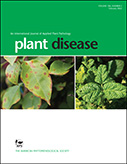Potato virus V (PVV) causes a disease of potato (Solanum tubersosum) in South and Central America, Europe, and the Middle East. We report here the complete genomic sequences of 42 new PVV isolates from the potato’s Andean domestication center in Peru and of eight historical or recent isolates from Europe. When the principal open reading frames of these genomic sequences together with those of nine previously published genomic sequences were analyzed, only two from Peru and one from Iran were found to be recombinant. The phylogeny of the 56 nonrecombinant open reading frame sequences showed that the PVV population had two major phylogroups, one of which formed three minor phylogroups (A1 to A3) of isolates, all of which are found only in the Andean region of South America (Peru and Colombia), and the other formed two minor phylogroups, a basal one of Andean isolates (A4) that is paraphyletic to a crown cluster containing all the isolates found outside South America (World). This suggests that PVV originated in the Andean region, with only one minor phylogroup spreading elsewhere in the world. In minor phylogroups A1 and A3, there were two subclades on long branches containing isolates from S. phureja evolving more rapidly than the others, and these interfered with dating calculations. Although no temporal signal was directly detected among the dated nonrecombinant sequences, PVV and potato virus Y (PVY) are from the same potyvirus lineage and are ecologically similar, so “subtree dating” was done via a single maximum likelihood phylogeny of PVV and PVY sequences, and PVY’s well-supported 157 ce “time to most common recent ancestor” was extrapolated to date that of PVV as 29 bce. Thus the independent historical coincidences supporting the datings of the PVV and PVY phylogenies are the same; PVV arose ≥2,000 years ago in the Andes and was taken to Europe during the Columbian Exchange, where it diversified around 1853 ce, soon after the European potato late blight pandemic. PVV is likely to be more widespread than currently realized and is of biosecurity relevance for world regions that have not yet recorded its presence.
Phylogenetics and Evolution of Potato Virus V: Another Potyvirus that Originated in the Andes
Citation: Fuentes, S.; Gibbs, A. J.; Adams, I. P.; Hajizadeh, M.; Kreuze, J.; Fox, A.; Blouin, A. G.; Jones, R. A. C. 2022. Phylogenetics and Evolution of Potato Virus V: Another Potyvirus that Originated in the Andes. Plant Disease. ISSN 1943-7692. 106(2). pp. 691–700.
2022-03-31
GENETIC RESOURCES, GENETICS, GENOMICS AND CROP IMPROVEMENT SCIENCES GGCI, POTATO AGRI-FOOD SYSTEMS, POTATOES
journal_article

